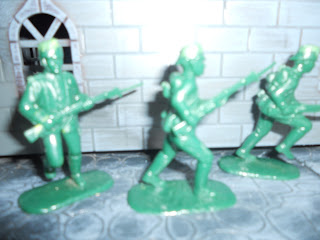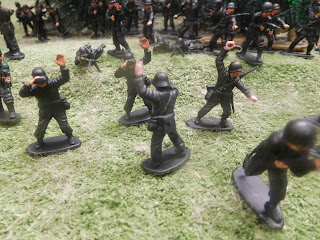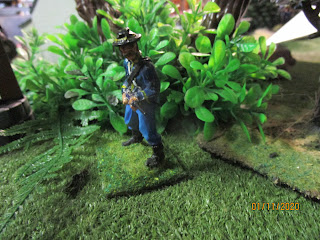What figures To Use For My Napoleon of Nottinghill Game
To be honest, for the vast majority of my life the only Chesterton I had heard of was Ian Chesterton, the Hartnell Doctor Who school teacher assistant.
Then, a couple of decades ago Paul Wright alerted me to this writer, G.K Chesterton and his story, The Napoleon of Nottinghill. The writer is a conservative philosopher, who knew HG Wells but had a very different picture of the future, one based on the values of the past rather than scientific progress. I have long been thinking of making it into a game. Paul had done so with a small number of figures and using shooting cannons from each figure.
The plot of the story is that a randomly selected king of England decided, as a joke, to reinstate Medieval or Renaissance local government, complete with antique modes of dress and weaponry. The book is set in 1984 and may have influenced Aldous Huxley's choice of year for his novel, Brave new World. What is odd for a 'futuristic' story is that technology and social norms (other than how the monarch is chosen) don't seem to have 'progressed' much from the time the book was written, in 1904.
The storyline develops when one of the characters, Adam Wayne, takes the antique show and pomp seriously and determines that as provost of the Burrough of Nottinghill he will resist intrusions from the rival borough of Kensington led by the provost, Buck.
Not a lot is said about weaponry other than halberds and edged weapons predominate but also with a nod to catapults and bows. The invading forces are more like the Edwardians, in clothing, and perhaps in weapons. Not a lot is said about firearms so I'll put a limit on their use but I am going to assume a mixture of matchlocks, flintlocks and 'modern' (early 1900s and late 1800s rifles and revolvers).
AI came up with some interesting answers to questions about the book but some of those were misleading; for example, one AI source referred to the enemies of Adam Wayne as 'government forces'. In fact, each borough was its own 'government'. However, Wayne's forces might have been more flaboyant in their attire.
So far I have assembled Beefeaters, medieval and Renaissance, WW1, Scots in kilts with broadswords (my own imagining), 'civilians' with rifles or shotguns, catapults and some conversions anachronistic mixes of Renaissance, medieval and Edwardian. Some cavalry were employed by Wayne. At least two battles took place but I'll possibly merge the two.
In Paul's game he had small units represented by cards, a number of which were blank. Much of the action in the novel took place at night and at one stage the street lamps went out. The invaders from Kensington got lost and began fighting each other. Paul represented the confusion by using cards and a dice roll that led to the Kensington forces staying in place.
I am gradually formulating my own rules, using some Warhammer result tables and heavily weighted in favor of the characters. As Wayne's men face twice, or even six times the numbers of the enemy I am going to give his army a few compensating rules. Apparently, they knew the territory and were good at ambushes. Perhaps some of them will come on from reserve from the flanks. The fighting took place in a built up area so I'll use plenty of passably Edwardian and Victorian buildings and maybe some steampunk looking structures.
BELOW: This vaguely 8th army cheapo army-man is one of the more horrible figures. What got my attention was that the poor attempt at a British tin helmet looks a lot like a bowler hat. I gave the figure new metal arms with revolver and sword and built up some renaissance looking attire. I added a sword scabbard from split pin and putty baggy pants and arms. A mix of renaissance and Edwardian attire will be most intersting. The bowler hat I could paint black or grey or even bright purple, red or metallic - such are the joys of fantasy gaming.
I also gave the baggy arms treatment to the BMC AWOI figure and a Lido WW2 US marine. The detail is basic so the firearms can be painted to represent matchlocks or whatever. Two of the figures will also have breastplates.Pirates and Elizabethans of various makes...
Edwardian-looking civilians...Figures at front are, left to right, ElastoWest, cheapo HK copy of a farmer and a repro.Charbens policeman. At rear are two metals, one being a home-cast copy of Britains (?) with rifle arm added. The other, at right, is a Britains civilian with rifle arm added.
Assorted highlanders with two Cherilea reissues at rear and the others being a conversion from a metal Viking with breast plate and the two at front are my resin copes, further modified. The charging with musket is Mel Gipson from The Patriot.
More assorted conversions and Starlux knight plus an ElastWit figure.
The two figures at far left, front, are my resin castings/conversions from an ElastoWit Napoleonic 95th Rifleman.
Group shot
WW1 metal Tommies at front13th Hussars, possible candidates for the cavalry
At front are some Technolog weird Napoleonics with the figure at far right being my conversion from BMC AWOI to fit with the others. They are depicted with chainmail coats. At rear are some of my resin castings from a commercial mold. They are closer to 1/35 but look good together as a unit.
The Soviets once made some 'capitalist' soldiers in top-hats and tails that would fit in right well here.
Any additional ideas from my readers are welcome.




















A curious book ripe for figure conversions. Beefeaters, Swiss Guards …
ReplyDeleteI think I have mentioned the postwar 1940s Ealing comedy film Passport to Pimlico with its own Burgundian self government separate from London / Britain as a parallel?
'A classic of British cinema'. https://en.wikipedia.org/wiki/Passport_to_Pimlico#Plot There have also been real life cases of small regions declaring themselves independent states. There was an old oil rig, somewhere which declared itself sovereign and the owner had to fight off German mercenaries. In the Napoleon of Nottinghill the boroughs were, I think, still subject to the king, who had come up with the idea in the first place. James
ReplyDeleteI am a big fan P to P too. Great movie, well worth watching. I had thought of adapting it into my VBCW gaming but have never got round to it…
DeleteAlan Tradgardland
Lots of great figure choice , most importantly you want to have fun, which you seem good at doing anyway. A mix of styles and periods adds the artificiality and fun of the period .
DeleteAlan Tradgardland